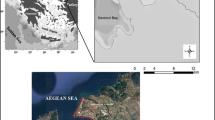Abstract
The period of date of death of an elephant can be assessed by analyzing four different radionuclides, 14C, 90Sr, 228Th and 232Th in its ivory. These nuclides are supposed to have variing concentrations at different parts of a tusk. The reason is the procedure of growth which takes place at the butt-site of a tusk. Therefore the site of sampling could have a big influence on the assessed date of death. However, to find out if the position of sampling is important a complete tusk was analyzed regarding the distribution of these nuclides. Results show that the concentration activity of 14C and 228Th varies in different parts of a tusk. The activity concentration of 90Sr is very similar in all analyzed parts. The conclusion is that sampling at the butt of a tusk is recommended for age assessment.






Similar content being viewed by others
Notes
International Atomic Energy Agency.
References
Brunnermeier MJ, Schmied SAK, Mueller-Boge M, Schupfner R (2011) Dating of ivory from the 20th century by determination of 14C by the direct absorption method. App Rad Iso (accepted 2011)
Elder WH (1970) Morphometry of elephant tusks. Zoo Afr 5(1):143–159
Hua Q, Barbetti M (2004) Review of tropospheric bomb 14C data for carbon cycle modeling and age calibration purposes. Radiocarbon 46:1273–1298
Kandlbinder R, Geissler V, Schupfner R, Wolfbeis O, Zinka B (2009) Analysing of 228Th, 232Th, 228Ra in human bone tissues for the purpose of determining the post mortal interval. J Rad Nucl Chem 280(1):113–119
Lafrenz KA (2003) Tracing the source of the elephant and Hippopotamus ivory from the 14th century BC. Uluburun Shipwreck: The archaeological, historical and isotopic evidence. Master thesis. Department of Anthropology, College of Arts and Sciences, University of South Florida. (http://scholarcommons.usf.edu/etd/1122/; November 2011)
Le Clercq M, van der Plicht J, Groening M (1998) New 14C reference materials with activities of 15 and 50 pMC. Radiocarbon 40(1):295–297
Levin I, Hammer S, Kromer B, Meinhardt F (2008) Radiocarbon observation in atmospheric CO2: determining fossil fuel CO2 over Europe using Jungfraujoch observations as background. Sci Total Environ 391:211–216
Pilgram T, Western D (1986) Inferring the sex and age of African elephants from tusk measurements. Biol Conserv 36:39–52
Raubenheimer EJ, van Heerden WFP, van Niekerk PJ, de Vos V, Turner MJ (1995) Morphology of the deciduous tusk (tush) of the African elephant (Loxodonta africana). Oral Biol 40(6):571–576
Raubenheimer EJ (1999) Morphological aspects and composition of African elephant (Loxodonta africana) ivory. Koedoe 42(2):57–64
Schmied SAK, Brunnermeier MJ, Schupfner R, Wolfbeis OS (2011) Age assessment of ivory by analysis of 14C and 90Sr to determine whether there is an antique on hand. Foren Sci Int 207:e1–e4
Schmied SAK, Brunnermeier MJ, Schupfner R (2011) Dating of ivory by determination of 14C, 90Sr and 228/232Th. Foren Sci Int (submitted Oct 2011)
Singh RR, Goyal SP, Khanna PP, Mukherjee PK, Sukumar R (2006) Using morphometric and analytical techniques to characterize elephant ivory. Foren Sci Int 162:144–151
Stuiver M, Polach H (1977) Discussion: reporting of 14C data. Radiocarbon 19:355–363
Weissengruber GE, Egerbacher M, Forstenpointner G (2005) Structure and innvervation of the tusk pulp in the African elephant (Loxodonta africana). J Anat 206:387–393
Acknowledgment
This work is advanced by the German Federal Agency for Nature Conservation and financially supported by the Federal Ministry for the Environment, Nature Conservation and Nuclear Safety. The tusk was also provided by the German Federal Agency for Nature Conservation.
Author information
Authors and Affiliations
Corresponding author
Rights and permissions
About this article
Cite this article
Brunnermeier, M.J., Schmied, S.A.K. & Schupfner, R. Distribution of 14C, 90Sr and 228Th in an elephant tusk. J Radioanal Nucl Chem 292, 1285–1290 (2012). https://doi.org/10.1007/s10967-011-1587-8
Received:
Accepted:
Published:
Issue Date:
DOI: https://doi.org/10.1007/s10967-011-1587-8




